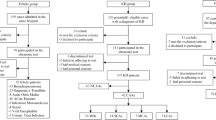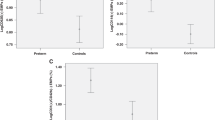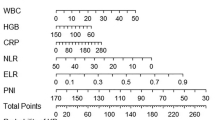Abstract
Background:
We investigated vascular endothelial dysfunction by sonographic features of flow-mediated dilation (FMD) and circulating endothelial microparticles (EMPs) in Kawasaki disease (KD).
Methods:
Twenty-eight patients with KD were prospectively grouped according to stage of disease: acute, subacute, and convalescent. In addition, 28 healthy children and 28 febrile children were selected as controls. And cases in the convalescent phase were divided into two subgroups: coronary artery lesion (CAL) and no coronary lesion (NCAL). CD144+/CD42b−, CD62E+, and CD105+ EMPs were measured by flow cytometry; FMD was obtained by sonography.
Results:
There were significant differences in FMD among the five groups. When compared with healthy controls, there were significantly greater numbers of CD144+/CD42b−, CD62E+, and CD105+ EMPs and a higher proportion of CD62E+ EMPs in KD patients. The proportions and numbers of CD144+/CD42b−, CD62E+, and CD105+ EMPs in KD patients were not statistically different than in febrile controls. There were no significant differences in FMD and EMPs between the CAL and NCAL subgroups. There were significantly negative correlations between the values of FMD and EMPs in the three phases of KD.
Conclusion:
The increased levels of EMPs have significant correlation with decreased values of FMD, both of which may reflect endothelial dysfunction in child KD.
Similar content being viewed by others
Log in or create a free account to read this content
Gain free access to this article, as well as selected content from this journal and more on nature.com
or
References
Gordon JB, Kahn AM, Burns JC . When children with Kawasaki disease grow up: myocardial and vascular complications in adulthood. J Am Coll Cardiol 2009;54:1911–20.
Ma XJ, Yu CY, Huang M, Chen SB, Huang MR, Huang GY ; Shanghai Kawasaki Research Group. Epidemiologic features of Kawasaki disease in Shanghai from 2003 through 2007. Chin Med J 2010;123:2629–34.
Orenstein JM, Shulman ST, Fox LM, et al. Three linked vasculopathic processes characterize Kawasaki disease: a light and transmission electron microscopic study. PLoS ONE 2012;7:e38998.
Mitani Y . Coronary endothelial dysfunction after Kawasaki disease. J Am Coll Cardiol 2000;35:821–3.
Fukazawa R . Long-term prognosis of Kawasaki disease: increased cardiovascular risk? Curr Opin Pediatr 2010;22:587–92.
Ikemoto Y, Ogino H, Teraguchi M, Kobayashi Y . Evaluation of preclinical atherosclerosis by flow-mediated dilatation of the brachial artery and carotid artery analysis in patients with a history of Kawasaki disease. Pediatr Cardiol 2005;26:782–6.
Urbina EM, Williams RV, Alpert BS, et al.; American Heart Association Atherosclerosis, Hypertension, and Obesity in Youth Committee of the Council on Cardiovascular Disease in the Young. Noninvasive assessment of subclinical atherosclerosis in children and adolescents: recommendations for standard assessment for clinical research: a scientific statement from the American Heart Association. Hypertension 2009;54:919–50.
Guiducci S, Ricci L, Romano E, et al. Microparticles and Kawasaki disease: a marker of vascular damage? Clin Exp Rheumatol 2011;29:Suppl 64:S121–5.
Tan Z, Yuan Y, Chen S, Chen Y, Chen TX . Elevated plasma endothelial microparticles together with TNF-alpha and IL-6 in Kawasaki Disease. Indian Pediatr 2013;50:501–3.
Celermajer DS, Sorensen KE, Gooch VM, et al. Non-invasive detection of endothelial dysfunction in children and adults at risk of atherosclerosis. Lancet 1992;340:1111–5.
Santos-García D, Rodríguez-Yáñez M, Arias-Rivas S, Blanco M . [Brachial arterial flow mediated dilation: utility in clinical and experimental practice]. Rev Neurol 2011;53:351–60.
Dignat-George F, Boulanger CM . The many faces of endothelial microparticles. Arterioscler Thromb Vasc Biol 2011;31:27–33.
Biasucci LM, Porto I, Di Vito L, et al. Differences in microparticle release in patients with acute coronary syndrome and stable angina. Circ J 2012;76:2174–82.
Amabile N, Heiss C, Real WM, et al. Circulating endothelial microparticle levels predict hemodynamic severity of pulmonary hypertension. Am J Respir Crit Care Med 2008;177:1268–75.
Feng B, Chen Y, Luo Y, Chen M, Li X, Ni Y . Circulating level of microparticles and their correlation with arterial elasticity and endothelium-dependent dilation in patients with type 2 diabetes mellitus. Atherosclerosis 2010;208:264–9.
Parker B, Al-Husain A, Pemberton P, et al. Suppression of inflammation reduces endothelial microparticles in active systemic lupus erythematosus. Ann Rheum Dis 2013; e-pub ahead of print 5 May 2013.
Bulut D, Tüns H, Mügge A . CD31+/Annexin V+ microparticles in healthy offsprings of patients with coronary artery disease. Eur J Clin Invest 2009;39:17–22.
Lackner P, Dietmann A, Beer R, et al. Cellular microparticles as a marker for cerebral vasospasm in spontaneous subarachnoid hemorrhage. Stroke 2010;41:2353–7.
Takahashi K, Oharaseki T, Yokouchi Y, Hiruta N, Naoe S . Kawasaki disease as a systemic vasculitis in childhood. Ann Vasc Dis 2010;3:173–81.
Clarke LA, Hong Y, Eleftheriou D, et al. Endothelial injury and repair in systemic vasculitis of the young. Arthritis Rheum 2010;62:1770–80.
Niboshi A, Hamaoka K, Sakata K, Yamaguchi N . Endothelial dysfunction in adult patients with a history of Kawasaki disease. Eur J Pediatr 2008;167:189–96.
Onouchi Y . Molecular genetics of Kawasaki disease. Pediatr Res 2009;65(5 Pt 2):46R–54R.
Amabile N, Guérin AP, Leroyer A, et al. Circulating endothelial microparticles are associated with vascular dysfunction in patients with end-stage renal failure. J Am Soc Nephrol 2005;16:3381–8.
Bulut D, Maier K, Bulut-Streich N, Börgel J, Hanefeld C, Mügge A . Circulating endothelial microparticles correlate inversely with endothelial function in patients with ischemic left ventricular dysfunction. J Card Fail 2008;14:336–40.
Esposito K, Ciotola M, Schisano B, et al. Endothelial microparticles correlate with endothelial dysfunction in obese women. J Clin Endocrinol Metab 2006;91:3676–9.
Ayusawa M, Sonobe T, Uemura S, et al.; Kawasaki Disease Research Committee. Revision of diagnostic guidelines for Kawasaki disease (the 5th revised edition). Pediatr Int 2005;47:232–4.
Suzuki A, Kamiya T, Kuwahara N, et al. Coronary arterial lesions of Kawasaki disease: cardiac catheterization findings of 1100 cases. Pediatr Cardiol 1986;7:3–9.
Kobayashi T, Inoue Y, Takeuchi K, et al. Prediction of intravenous immunoglobulin unresponsiveness in patients with Kawasaki disease. Circulation 2006;113:2606–12.
Newburger JW, Takahashi M, Gerber MA, et al.; Committee on Rheumatic Fever, Endocarditis, and Kawasaki Disease, Council on Cardiovascular Disease in the Young, American Heart Association. Diagnosis, treatment, and long-term management of Kawasaki disease: a statement for health professionals from the Committee on Rheumatic Fever, Endocarditis, and Kawasaki Disease, Council on Cardiovascular Disease in the Young, American Heart Association. Pediatrics 2004;114:1708–33.
Author information
Authors and Affiliations
Corresponding author
PowerPoint slides
Rights and permissions
About this article
Cite this article
Ding, YY., Ren, Y., Feng, X. et al. Correlation between brachial artery flow-mediated dilation and endothelial microparticle levels for identifying endothelial dysfunction in children with Kawasaki disease. Pediatr Res 75, 453–458 (2014). https://doi.org/10.1038/pr.2013.240
Received:
Accepted:
Published:
Issue date:
DOI: https://doi.org/10.1038/pr.2013.240
This article is cited by
-
Elevated circulating endothelial microparticles (EMPs) in prepubertal children born preterm
Pediatric Research (2022)
-
Predictive value of brachial artery flow-mediated dilation on coronary artery abnormality in acute stage of Kawasaki disease
Scientific Reports (2021)
-
MicroRNA-145-5p and microRNA-320a encapsulated in endothelial microparticles contribute to the progression of vasculitis in acute Kawasaki Disease
Scientific Reports (2018)
-
Coronary artery aneurysm regression after Kawasaki disease and associated risk factors: a 3-year follow-up study in East China
Clinical Rheumatology (2018)



